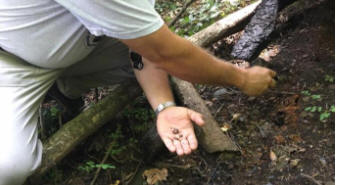
The Great Smoky Mountain Journal
Staff Reports
Posted: Sunday, January 21, 2018 11:24 AM
New Fungi Helping Forrest Regrow In Great Smoky National Park Following Last Year's Wildfires
"It's only been a few months, but we can already see fungi are growing back again," said Dr. Andrew Miller. "Here's one that's fruiting."
Dr. Miller, a mycologist from the University of Illinois, and his team from the University of Tennessee and Savannah State University found what they're looking for: pyro-nema, a tiny fungi that only grows after a fire.
"They've basically been sitting in the soil as spores waiting for the fires to come along, and as soon as that happens they fruit in abundance and they're basically all over the place," he said.
These tiny particles are the food for the plants and the trees to sprout again.
"These fungi are the first to come in, they help decompose all the other stuff until the rest of the growth comes in," Miller explained.
There's lots of different fungi that grow in the park, but this pyro-nema is a new species, and it's here to nourish the forest.
"These are all new park records that we've never seen in the park, and this is really exciting because we know of over 3,000 species in the park that we've studied for years. We've really studied the park well for the last 100 years, we have a good diversity of knowledge of what occurs in the park, and we've never seen this before so it's really exciting for mycologists to come and see it," said Dr. Miller.
The first signs of new life make these scientists optimistic for the future of the forest.
"It was a high intensity burn and pretty much everything was burned down to the ground, and to see things coming up in that area just a few months after the fires is impressive," said Dr. Andy Methven, biologist at Savannah State University and UT graduate. "I've been impressed with how quickly the plants have sprouted, even in the last month, it's amazing how quickly it's recovering."
"Probably this time next year you're going to have a hard time telling a fire even came through this area. The soil is going to be pretty much back to the way it was before," added Dr. Miller.
Eleven thousand acres burned in the park in November. The group of researchers received a $160,000 grant called Post-Fire Fungi with Great Smoky Mountains National Park with the National Science Foundation and received permits to conduct the research with the national park.

